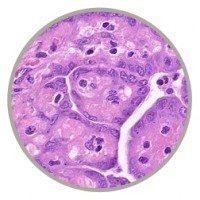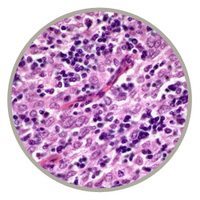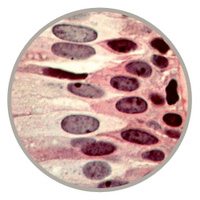Mesothelioma Cells Type

Epithelioid Mesothelioma
 Definition
Definition
The entire human body and all of its internal and external organs are covered with epithelial tissue. These protective tissue clusters are packed very close together, with little to no space between cells.
Epithelial tissue is what makes human skin waterproof. There are eight types of epithelial tissues, including transitional cells that line the bladder, simple cuboidal cells found in the kidneys, and stratified squamous cells that line the skin, throat and esophagus.
Epithelial tissue is different from connective, muscle and nervous tissue because each cell is polarized, attached to one another, and is attached by a basement membrane to underlying tissue. Malignant pleural mesothelioma cancer is by far the most common epithelioid-related diagnosis. It comprises 75 percent of all mesothelioma cases, according to the American Cancer Society.
Occupational exposure to asbestos is directly related to more than 90 percent of these cases. Asbestos is inhaled and the sharp fibers literally dig into the epithelial tissue lining the lungs. The inflammation caused by the asbestos fibers leads to malignancy.
Diagnosis
The latency period can range anywhere from 15 to 60 years. This is why mesothelioma mostly affects older people. Those diagnosed with papillary mesothelioma in the age 30 to 40 range were usually exposed to asbestos as children in some way. An epithelioid mesothelioma diagnosis is difficult for doctors simply because many of the symptoms resemble common ailments.
Chest pain, shortness of breath, unexplained weight loss, and a chronic cough. Doctors will first determine any history of asbestos exposure with the patient. It then comes down to diagnosing the type of mesothelioma, then the affected cell type (i.e. epithelioid).
A computerized tomography (CT) scan is useful for pinpointing, among other things, nodular pleural thickening and mediastinal pleural involvement. These are sure signs of pleural mesothelioma.
Immunohistochemistry, a procedure used to differentiate between malignant mesothelioma and other cancers, may also be used for determine a positive diagnosis. Needle and cytology biopsies are sometimes used, but can be ineffective due to the small sample sizes derived thereof.
Prognosis and Treatment
The treatments available and prognosis for epithelioid mesothelioma depends entirely on the stage and location. A 1994 study published in the European Respiratory Journal found that stage 1 patients lived for 359 days after diagnosis. Stage 3 and 4 patients lived for 112 days on average.
A 2011 University of South Wales (Australia) study found that estrogen receptors in women may suppress the development of tumors, giving females a longer prognosis than men. Younger patients also tend to live longer due to more treatment options being available to them.
Epithelioid mesothelioma accounts for a vast majority of diagnosis, thus there are more treatments available and a longer prognosis. Some combination of surgery, radiation, and chemotherapy (also called multimodal therapies) is normally the course of action to attack the cancer.
A multimodal treatment may include an extrapleural pneumonectomy (surgical removal of the affected lung, along with parts of the chest and heart lining), then localized radiation to reduce the risk of recurrence. The current relative five-year survival rate for mesothelioma patients is nearly 10 percent, which is significantly higher than the rate in the 1980s.
Anyone who believes they were exposed to asbestos at any point in their lives to see a doctor even if symptoms seem minor. The sooner the diagnosis, the longer the prognosis.
Sarcomatoid Mesothelioma
 Sarcomatoid mesothelioma comprises only 7 to 20 percent of all new diagnoses in the U.S., making it the least common form. It is also the most aggressive and deadliest of the three histological cell types.
Sarcomatoid mesothelioma comprises only 7 to 20 percent of all new diagnoses in the U.S., making it the least common form. It is also the most aggressive and deadliest of the three histological cell types.
A 2002 study of 108 sarcomatoid renal cell carcinoma patients at the University of Texas M.D. Anderson Cancer Center, found that metastasis (spreading of the cancer) was present in 77 percent of them.
Sarcomatoid cells affect supportive tissue, like bones, muscles, and cartilage as opposed to the membranous tissue affected by epithelioid diagnoses.
Definition
Sarcomatoid mesothelioma, like all other forms of the disease, is caused by exposure to asbestos. The cells are less uniform in structure and have a far more random arrangement than their epithelioid counterparts. The cells are oval-shaped, much like a spindle, and contain no nucleus.
There are three variants of sarcomatoid cells: transitional, lymphohistiocytosis, and desmoplastic. Transitional cells are termed as such because it is difficult for doctors to distinguish between from metastatic carcinoma cells.
They closely resemble a maturation stage between the extremes of surface mesothelium and the reactive potential of injured serosal tissue, according to a study published in the journal Clinics in Laboratory Medicine in 1987. Lymphohistiocytic is an extremely rare subtype making up only 1 percent of all asbestos-related cancers.
Tumors consisting of thick bundles of inflamed white blood cells, histiocytes, and plasma cells are the main characteristics of this type. It is often misdiagnosed as lymphoma. Desmoplastic cells were first discovered in 1980. These patternless cells can remain undetected until they spread to adipose tissue in the chest wall.
Diagnosis
The resemblance between various malignant and benign conditions to sarcomatoid tumors makes diagnosis extremely difficult for doctors. Some of the more common initial misdiagnosis include fibrosarcoma, localized fibrous tumors and malignant fibrous histiocytoma.
Doctors will first determine if the patient has a history of occupational asbestos exposure. An MRI, CT scan, or some other imaging test is administered to determine if any abnormalities are present. A study published in the journal Modern Pathology in 2010 documented 326 cases of sarcomatoid mesothelioma.
Nearly every patient (98 percent) had pleural tumors, located in the fluid between the chest wall and lungs. Tissue samples via a biopsy are taken to determine the cell type. The traditional methods of biopsies, mainly the “needle core,” are ineffective for diagnosing sarcomatoid mesothelioma because of its aforementioned similarities to other conditions.
The samples are generally too small, which only increase the chance of misdiagnosis and being given improper treatments and wasting valuable time. Immunohistochemistry is the best procedure for an accurate diagnosis. The technique involves tissue-staining and studying the reactions between certain antibodies and the proteins derived from the tissue samples. But because of the three variants of cells, a proper diagnosis is extremely difficult even with this technique. A second and even third opinion is recommended for the most accurate diagnosis.
Prognosis and Treatment
Unfortunately sarcomatoid mesothelioma is highly resistant to most of the current available treatment options. Thus the median survival rate is less than six months. Some younger patients and those with otherwise good health can live longer. Surgery is highly ineffective to treat sarcomatoid mesothelioma due to metastasis in the chest cavity, making them extremely difficult to safely remove. Chemotherapy has also proven to be highly ineffective fighting sarcomatoid mesothelioma.
The disease is rare, so clinical trials are few and far between for testing new treatments. A 2006 study published in the journal Free Radical Biology and Medicine found that sodium selenite can be effective in treating sarcomatoid mesothelioma. The research suggests that selenite induces apoptosis (programmed death) of the cancer cells. The selenite activated a protein in the sarcomatous cells called Bax, which promotes cell death. The treatment, however, is still in the experimental stages and more tests are needed. If you are suffering symptoms such as shortness of breath, unexplained weight loss, and/or a chronic cough, see a doctor right away.
Biphasic mesothelioma
 Biphasic mesothelioma cases have physical characteristics of both epithelioid and sarcomatoid mesothelioma. The previous are continuous square-shaped malignant cells with a nucleus, while the latter are oval-shaped with no identifiable nucleus. Biphasic mesothelioma is most common in pleural patients. Approximately 20-35 percent of all mesothelioma cases are classified as biphasic, making it the second-most common type of the disease. Though both types of malignant cells are found in biphasic patients, they are usually in different areas of the tumor.
Biphasic mesothelioma cases have physical characteristics of both epithelioid and sarcomatoid mesothelioma. The previous are continuous square-shaped malignant cells with a nucleus, while the latter are oval-shaped with no identifiable nucleus. Biphasic mesothelioma is most common in pleural patients. Approximately 20-35 percent of all mesothelioma cases are classified as biphasic, making it the second-most common type of the disease. Though both types of malignant cells are found in biphasic patients, they are usually in different areas of the tumor.
Diagnosis
Like all other forms of mesothelioma, visible symptoms for biphasic patients can take 15-60 years to show up after asbestos-exposure. Some of the most common symptoms include lower back pain, trouble swallowing, shortness of breath, swollen arms and face, and pain in the chest area. The prolonged latency period, along with common symptoms resembling other minor ailments, are the primary reasons biphasic mesothelioma is usually not diagnosed until stage 3 or 4.
Biphasic mesothelioma is difficult to diagnose due to inadequate tissue sample sizes taken by typical biopsies. A 2012 study by the Department of Pathology at the Thessaloniki (Greece) General Hospital found that even using immunohistochemical and morphological methods could not definitively clarify whether a patient suffered from reactive mesothelial proliferations or biphasic pleural mesothelioma.
Another study published in the March 2011 Journal of Thoracic Oncology found that of 19 patients initially diagnosed with biphasic mesothelioma, only five were correctly diagnosed at final review. Most of those patients were initially diagnosed as biphasic before extrapleural pneumonectomy (surgical removal of a lung) with a thoracoscopy or CT scan.
Surgical biopsies are generally the most accurate, as doctors can examine a larger part of the tumor from several different areas. This helps rule out synovial sarcomas and carcinosarcomas, which are easy to mistake for biphasic mesothelioma. Fujirebio Diagnostics, a Japan-based bio-tech firm, recently developed an in vitro test called MESOMARK.
It could potentially identify biphasic mesothelioma at earlier stages to increase the number of treatment options available. Regardless of the methods used in diagnosis, a second opinion is highly recommended if biphasic mesothelioma is the initial diagnosis.
Treatment and Prognosis
Unfortunately due to the the fact biphasic mesothelioma is usually not detected until stage 3 or later, there are few effective treatments available. The most important factor when determining treatments is the ratio between epithelioid and sarcomatoid cells. Malignant epithelial cells are far more responsive to treatment than sarcomatoid cells.
Patients with more epithelial cells will have more options for treatments and a brighter outlook. Chemotherapy and radiation are sometimes administered, while most other treatments focus solely on pain management and relief from other symptoms.
A study published this year in the Slovak Academy of Sciences journal Neoplasm tested the effects enzymes called carbonic anhydrase IX (CAIX) in identifying mesothelioma cells via immunohistochemical staining.
Though the data suggests that CAIX is not an accurate tool for distinguishing healthy cells from cancer cells, researchers said the use of CAIX has potential in diagnosing advanced staged biphasic mesothelioma. The prognosis for stage 3 and 4 biphasic mesothelioma is about 6-8 months.
The earlier the disease is detected, the more treatment options will be available. See a doctor immediately if you have a history of asbestos-exposure and are experiencing any of the aforementioned symptoms.
Sources & Author:
- Journal of Thoracic Disease
- Fujirebio Diagnostics, Inc.
- The National Center for Biotechnology Information
- Nature.com
- The National Center for Biotechnology Information
- Cancer.gov
- The National Center for Biotechnology Information
- Cancer Research UK
- Boundless
- Hartnell College
- Cancer.org
- European Respiratory Journal
 Definition
Definition